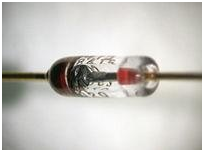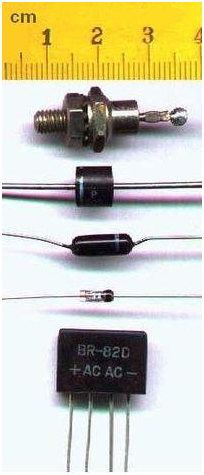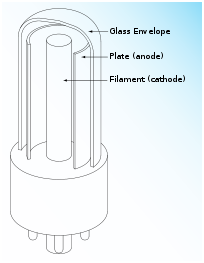Diode

Figure- Closeup of a diode, showing the square shaped semiconductor crystal.

Figure- Various semiconductor diodes. Bottom: A bridge rectifier. In most of the diodes, a white or black painted band identifies cathode terminal, which means, the terminal which conventional current flows out of when diode is conducting.

Figure- The structure of a vacuum tube diode. The filament can be bare, or more commonly (as shown here), embedded within and insulated from the enclosing cathode
Diode is the two-terminal electronic component which conducts electric current in only one direction. The term generally refers to a semiconductor diode, the most common type today. This is a crystalline piece of semiconductor material linked to two electrical terminals. A vacuum tube diode (now little used except in some high power technologies) is a vacuum tube with 2 electrodes; a plate and a cathode.
The most ordinary function of a diode is to let an electric current to pass in one direction (called the diode's forward direction) while blocking current in opposite direction (which is reverse direction). Therefore, the diode can be thought of as an electronic version of the check valve. This unidirectional behavior is known as rectification, and is used to convert alternating current to direct current, and to extract modulation from radio signals in the radio receivers.
Diodes can have more complicated behavior than this simple on-off action, because of their complex non-linear electrical characteristics, which can be tailored by varying construction of their P-N junction. These are exploited in special purpose diodes which perform several different functions. For instance, specialized diodes are used to regulate the voltage (Zener diodes), to electronically tune radio and TV receivers (varactor diodes), to produce radio frequency oscillations (tunnel diodes), and to produce light (light emitting diodes).
The diodes were first semiconductor electronic devices. The discovery of crystals' rectifying abilities was made by German physicist Ferdinand Braun in the year 1874. The first semiconductor diodes, known as cat's whisker diodes were made of crystals of minerals like galena. Today most diodes are made up of silicon, but other semiconductors like germanium are used sometimes.
Email based Electronics Devices and circuits assignment help - homework help at Expertsmind
Are you searching Electronics Engineering assignment help expert for help with Diode questions? Diode topic is not easier to learn without any external help? We at www.expertsmind.com offers free lecture notes for Electronics Devices and circuits assignment help and Electronics Devices and circuits homework help. Live tutors are available 24x7 hours for helping students in their Diode related problems. We provide step by step Diode question's answers with 100% plagiarism free content. We prepare quality content and notes for Diode topic under Electronics Devices and circuits theory and study material. These are avail for subscribed users and they can get advantages anytime.
Why Expertsmind for assignment help
- Higher degree holder and experienced experts network
- Punctuality and responsibility of work
- Quality solution with 100% plagiarism free answers
- Time on Delivery
- Privacy of information and details
- Excellence in solving electronics engineering questions in excels and word format.
- Best tutoring assistance 24x7 hours